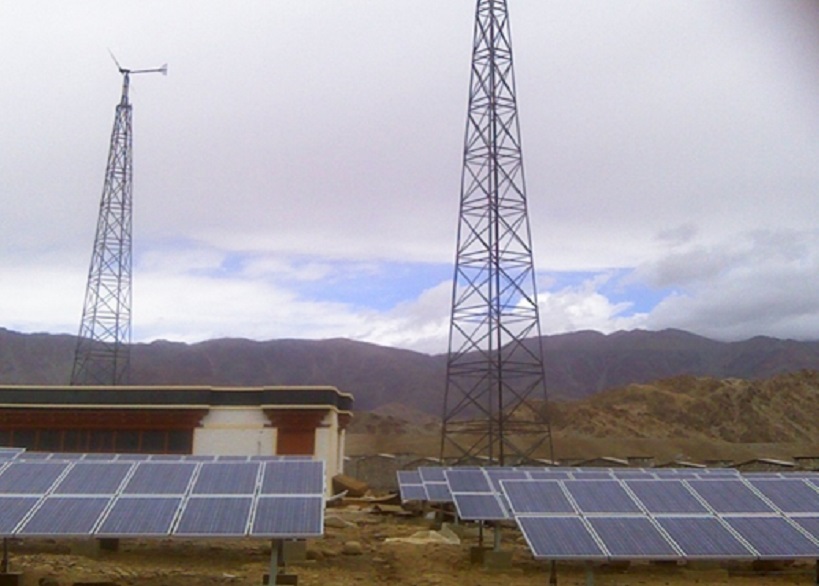Distributed, grid-connected solar PV with battery storage systems offers a unique set of benefits without the challenges as seen with mega-scale execution. In distributed solar applications, small PV systems (500 kW to 2-3 MW scale) generate electricity for on-site local centralized consumption and interconnect with low-voltage to high-voltage grid sub-station transformers on the electric utility system.
With falling PV system and battery storage prices, coupled with declining trends in solar EPC turnkey cost, deploying distributed PV with a storage system and evacuating solar energy at 11 kV/33 kV level is an attractive proposition. This will reduce transmission line losses, increase grid resilience to rural feeders, avoid transmission distribution loss, reduce generation costs, and reduce investment cost in new utility generation capacity.
With proper selection of equipment, installation of the well-engineered system and long-term operation and maintenance (O&M), distributed PV with appropriate battery storage systems at each sub-station will mitigate reliability issues by providing standby capacity during electric utility disturbances, grid outages, and load shedding.
Solar energy source, i.e., SUN, is available all across the country for almost 300 days in a year. Therefore it is the most suited and reliable source for distributed solar energy generation. Increasing amounts of distributed solar generation (DG) connected to distribution networks of Discoms with a virtual energy storage system will provide reliable power through proper voltage control in the distribution network.
The downside of mega-scale solar
The Ministry of New and Renewable Energy (MNRE) has recently issued amendments regarding the setting up of 12 GW of solar projects with viability gap funding (VGF) support by central public sector undertakings (CPSU) for self-use or use by government entities.
After the repeated no-bid situation, the Indian Renewable Energy Development Agency Limited (IREDA) has been entrusted with the task of carrying out the bidding process replacing the Solar Energy Corporation of India (SECI), which was the implementing agency for this program.
As per the amended clause, the VGF will be released in two tranches by IREDA. The amendment also covers new guidelines for bidding, evaluation, the award of the project, a timeline of 24 months for implementation, tariff rate reduced to Rs 2.80/kWh from Rs 3.5/kWh, and VGF provided from the central assistance.
The proposed huge viability gap funding (VGF) of Rs 7 million/MW and expenditure on the HVDC and EHV transmission system to support mega-scale solar farms across the country should be diverted to the immediate implementation of the KUSUM scheme with the provision of battery storage at each 33/11 kV substation to ensure success in the near term.
The huge investment plan in the development of HVDC and EHV transmission systems will further need sufficient time of 24 to 36 months to realize and match solar power mega-scale farm development. The energy yield in these farms will be limited to 20-22% of the capacity and accordingly, the HVDC lines and substations will run under-loaded (no power flow in the non-solar period).
The entire investment on mega-scale solar development with EHV transmission infrastructure and disbursement of VGF funds will not be viable.
This huge mega-scale solar penetration into the existing grid will create load unbalancing and power disruption due to the variable nature of solar power generation. Further, higher penetration of solar power will face curtailment during peak generation.
Suggestions
Immense solar resource is available throughout the country and solar electricity can be produced everywhere. This must be realized with large-scale investment in distributed solar generation plus battery storage.
The merits of distributed solar generation plus battery storage are:
- Potential to supply electricity during grid outages and blackouts resulting from extreme weather conditions or other emergency situations.
- Significantly increased resiliency of the electricity system
- Ancillary services to the grid, such as voltage control, demand-side management to smoother peaks in the load on the utility system and improved power quality (e.g., batteries can smooth the variable output of a PV system)
- Electricity supply to critical facilities during major power outages and grid failures
- An increased ability to integrate high levels of distributed generation onto the electricity system
- No requirement of a huge investment in the transmission system
India has about 5500 to 6000 33/11 kV substations across the country, where 500 kW to 2 MW solar power can be added to support the development. Adding battery storage at each substation under the KUSUM scheme will provide complete energy security to all sections of consumers in rural India.
The MNRE has announced the KUSUM scheme and faithful implementation by distribution licensees will revolutionize solar development in the country in the shortest period with minimum investment.
A well-designed storage facility with a distributed PV system will ensure the prevention of power disruption, protection of life and property dependent on electricity service, and reduced time needed to restore service and recover the electricity supply.
The views and opinions expressed in this article are the author’s own, and do not necessarily reflect those held by pv magazine.
This content is protected by copyright and may not be reused. If you want to cooperate with us and would like to reuse some of our content, please contact: editors@pv-magazine.com.








2 comments
By submitting this form you agree to pv magazine using your data for the purposes of publishing your comment.
Your personal data will only be disclosed or otherwise transmitted to third parties for the purposes of spam filtering or if this is necessary for technical maintenance of the website. Any other transfer to third parties will not take place unless this is justified on the basis of applicable data protection regulations or if pv magazine is legally obliged to do so.
You may revoke this consent at any time with effect for the future, in which case your personal data will be deleted immediately. Otherwise, your data will be deleted if pv magazine has processed your request or the purpose of data storage is fulfilled.
Further information on data privacy can be found in our Data Protection Policy.